Abstract
Measurements of dust emissions and the modeling of dissipation dynamics and total values are related to great uncertainties. Agricultural activity, especially soil cultivation, may be an essential component to calculate and model local and regional dust dynamics and even connect to the global dust cycle. To budget total dust and to assess the impact of tillage, measurement of mobilized and transported dust is an essential but rare basis. In this study, a simple measurement concept with Modified Wilson and Cook samplers was applied for dust measurements on a small temporal and spatial scale on steep-slope vineyards in the Moselle area. Without mechanical impact, a mean horizontal flux of 0.01 g m2 min−1 was measured, while row tillage produced a mean horizontal flux of 5.92 g m2 min−1 of mobilized material and 4.18 g m2 min−1 emitted dust from site (=soil loss). Compared on this singular-event basis, emissions during tillage operations generated 99.89% of total emitted dust from the site under low mean wind velocities. The results also indicate a differing impact of specific cultivation operations, mulching, and tillage tools as well as the additional influence of environmental conditions, with highest emissions on dry soil and with additional wind impact. The dust source function is strongly associated with cultivation operations, implying highly dynamic but also regular and thus predictable and projectable emission peaks of total suspended particles. Detailed knowledge of the effects of mechanical impulses and reliable quantification of the local dust emission inventory are a basis for analysis of risk potential and choice of adequate management options.
1. Introduction
Wind erosion and emission of mineral dust are traditionally associated with the global drylands [1], with the highest percentage originating from hot deserts [2]. The related dynamics have been related to climatic drivers of aridity, soil moisture, and substrate, but also to anthropogenic impacts such as agriculture and livestock management, e.g., in Israel [3], the US Midwest [4], Australia [5], and China [6]. In Europe, severe wind erosion events have been associated with singular strong wind events and periods of increased wind energy [7] or studied under semi-arid conditions such as in Spain [8]. The anthropogenic impact has been considered the main trigger for wind erosion and dust emissions [9]. Climate change and land use change may severely increase the threat of wind erosion and dust emissions on a global scale [10]. Prolonged drought periods and intensified food production for a growing population under increasingly unfavorable soil and climate conditions are likely to expand vulnerable areas also in humid and sub-humid regions [11,12]. On a global scale, 25% of total dust emissions are estimated to originate from anthropogenic sources, predominantly agricultural areas [13], and 1000–3000 million tons per year of dust emissions are estimated to originate from global soils [14] including 6–30 million tons of fine dust with an aerodynamic diameter <10 µm PM10 [15]. The great variations in estimations of mineral dust emissions to the global atmosphere are largely attributed to a lack of agreement between models [16]. Land use change and inappropriate agricultural practices have expanded areas prone to wind erosion worldwide in recent decades [17]. Deflation induces the loss of fertile topsoil and release of mineral dust, implying yet unassessed ecological and socio-economic impacts such as the mobilization and redistribution of soil organic carbon, nutrients and also pollutants [18,19,20], human health issues particularly concerning fine dust [21], impacts on global climate [22] and extreme costs [23] also in Europe [24]. On a global scale, the dust cycle is known to be connected to continental and marine biogeochemical transport systems such as the carbon-, silica- and iron cycle [25], but local and regional emission paths and interactions are widely unknown. Nearby settlements may be under threat of dust emissions from arable land, especially concerning infrastructure [26] and human health: coarse dusts interfere with breathing and irritate the eyes, and fine dusts are subject to global [27] and European [28] standards.
1.1. Processes of Wind Erosion and Dust Emission with and without Mechanical Impact
The indirect impacts of mechanical disturbances of land surfaces from agriculture [29] and also grazing animals [30] have been acknowledged to increase wind erosion and total suspended particle (TSP) emissions, but very few individual studies have investigated the direct impact that may be a powerful trigger for an increase in TSP from arable land [31,32]. Wind erosion from arable land is of particular importance since chemical residues from fertilizers and pesticides as well as pathogens can be transported beyond fields along with the mineral components [33] and soil organic carbon [34].
In the specific context of mechanical impacts such as tillage operations, there are clear differences in the origin of airborne particles due to (i) processes of wind erosion and (ii) particle entrainment by external mechanical impacts such as tilling or driving. While wind erosion is an important cause of dust emissions from arable land, it may not be the most effective mechanism particularly in regions that are not arid or semi-arid.
(i) Detachment and transport of soil surface material is initiated if a threshold wind velocity dependent on particle characteristics is exceeded [35]. The impact of colliding particles (impact/dynamic threshold) equals the rate of impacting particles and momentum dissipation at the surface [36], mobilizes more material than drag and lift forces alone (fluid/static threshold) and may increase with distance downwind (fetch effect, e.g., [37,38]). The release of finer particles and dust is considered mostly associated with bombardment (sandblasting) [39], since aerodynamic forces alone are not powerful enough to overcome the strong cohesive forces of the fine dust particles [40,41]. (ii) Processes of particle detachment by impact of external triggers differ in so far as the threshold velocity is not the limiting factor for particle entrainment and total particle flux. The external trigger lifts the particles into the air where they float for a duration according to their size, shape and density. Much lower wind velocity is sufficient for transport compared to detachment, thus larger and more particles may be potentially released into suspension by this externally triggered mechanism than by sole wind erosion without mechanical impact.
The impact of (i) and (ii) are both key parameters for reliable assessment of dust emissions, but only (i) has been researched in more detail. Field observations are the basis for developing and testing dust modeling approaches [42], but to date most measurements do not provide enough information to determine the mechanisms that lead to dust emissions and often focus on a small variety of soil and atmospheric conditions [43].
1.2. Tillage Induced Airborne Dust and Dust Emissions from Vineyards
Viticulture is a traditional management system in many European regions, including (steep) slope terrain in southwestern Germany. As a crop adapted to specific climatic conditions, it is particularly common in southern European regions where it may exceed 8% of the total agricultural area, and reaches as far north as northern Germany and southern Scandinavia [44]. In vineyards and especially in steep slope vineyards, climate change-induced extended periods of drought and heat waves may lead to dry substrates and strong thermal winds, increasing the likelihood for wind erosion events with and without simultaneous tillage impact. Vineyards have been a topic of research concerned with the measurement [45] and modeling [46] of water erosion and redistribution of soil material by tillage [47] but have not been addressed in terms of wind erosion and dust emissions. Various tillage practices are applied during a cultivation cycle, among them tillage of the whole vineyard ground, mulching, and deep-tillage. The tillage of the area directly underneath the vine plants is an application increasingly used instead of chemical applications to reduce water competition and risk of diseases. This row-tillage is associated with lower amounts of applied herbicides and pesticides and is an increasingly used option due to an increasing percentage of conservatively and organically managed vineyards as well as a prospective glyphosate ban in Europe. The tested vineyard soils are assumed relatively stable against wind erosion due to an often nearly complete vegetation or stone cover and a generally high coarse soil content. Tillage operations may be initially responsible for large total amounts and the largest percentage of dust emissions originating from the vineyard site in a given period (Figure 1).
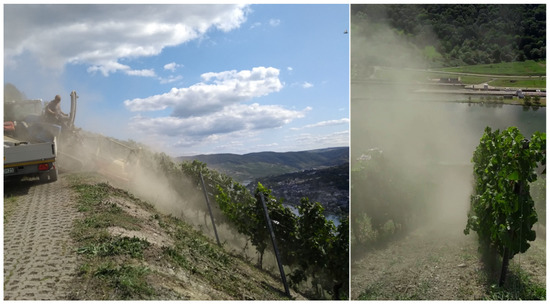
Figure 1.
Dust emissions during a cultivation procedure accompanied by thermals. The tillage device has just arrived back at the top slope, the dust is following the slope-parallel ascending air.
The research hypotheses for the study were
- The tested low-cost on-site test scheme including sediment samplers MWAC sampler is adequate to quantify dust emissions from vineyards on a small temporal and spatial scale;
- Vineyards are a potential dust source particularly during cultivation activities;
- The measured dust fluxes are related to environmental conditions and tillage tools.
2. Materials and Methods
2.1. Study Site
The investigations were carried out in the Moselle region on vineyards of the Service Center for Rural Areas (DLR) Rhineland-Palatinate (Figure 2). The wine region “Mosel” is famous for its characteristic steep slope viticulture and specific substrate. Due to reasons related to management, two vineyard sites were tested that resembled each other in key geomorphological, pedological and climatological characteristics. The steep-slope vineyards have a 25–35° inclination and are exposed south-southwest.
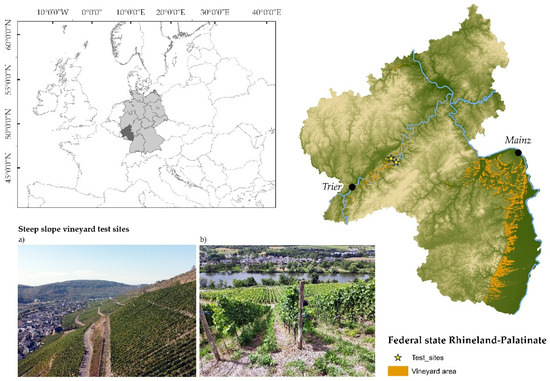
Figure 2.
Study sites (a) Zeltingen and (b) Kues in the Moselle area.
The soils are Eutric skeletic Regosols (WRB) with characteristic features of the regional vineyard substrates and developed on the main solifluction layer of Devonian schists. A specific horizon originating from irregular deep tillage is found up to a depth of 0.30 m. The soil type is very sandy loam (SI4) with 31% coarse soil fraction and 47% sand, 14% silt and 8% clay. The generally coarse substrate contains 22% particles < 63 µm, accounting for a comparably high percentage of material with a high sinking velocity potentially available for further transport in air (Figure 3).
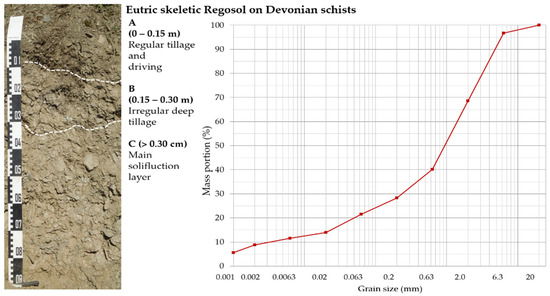
Figure 3.
Characteristics of tested vineyard soils at study sites.
2.2. Data Collection and Processing
For a first assessment of dust emission potential particularly associated with soil cultivation, a simple first approach was implemented with the installation of Modified Wilson and Cook (MWAC) samplers. The study design included control samples without tillage impact and measurement of mobilized and transported dust during tillage processes. The control samples without impact of tillage were collected in six rows at 0.4 m height over the course of 8 h under dry soil and low to medium wind conditions. For measurement of impact of tillage, four MWACs were installed on the tillage device directly above the tools 0.4 and 1.0 m above ground (Figure 4d). To tackle possible variances in dust emission potential from different cultivation tools, each tool was tested separately. The tool combinations for cultivation underneath the vine plants were rotary-star tiller–finger hoe (RT-FH, Figure 4a), disc plough–finger hoe (DP-FH, Figure 4b) and rotary-star tillers (RT, Figure 4c). An additional set of data (2 × 2 samples) was derived during mulching.
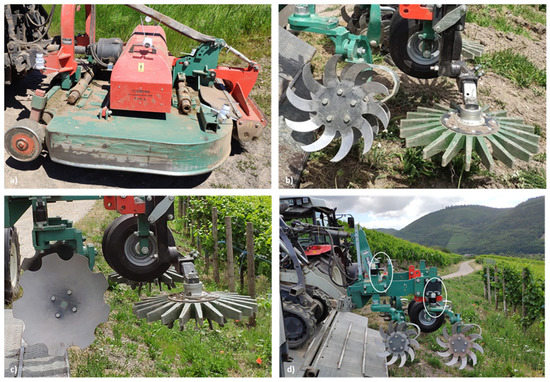
Figure 4.
(a) Mulcher, (b) rotary-star tiller–finger hoe, (c) disc plough–finger hoe and (d) rotary-star tillers with equipped with MWAC samplers (marked).
The test setup was designed to assess two modes of dust (Figure 5), the mobilized and the transported TSP. Dust collectors were attached directly to the cultivation device during cultivation in order to measure the total mobilized sediment hurled up and floating in the close vicinity of mobilization (Figure 5 (1)). In order to measure material drifting over longer distances, masts with five MWACs at heights 0.1, 0.2, 0.4, 1.0 and 1.8 m were positioned at the end of each row that was being tilled (Figure 5 (2)). Substrate material was caught if it was released and dissipated slope-parallel.

Figure 5.
Measurement design and location of dust samplers.
Three sets of tests were conducted under differing environmental conditions at different sites with slightly differing geomorphological characteristics such as slope and substrate structure, soil moisture and wind velocity. The factors soil moisture and wind velocity depended on time of soil cultivation (July, September, November), and the test design changed slightly during the test phase, resulting in a different number of tests for each set for statistical processing. Table 1 shows all repetitions for each test type conducted during cultivation for each sampler location.

Table 1.
Total number of samples and tests.
2.3. Data Analysis
The measurement values were derived from tillage operations on rows of 60 m length with a caterpillar moving with an average velocity of 3.6 km h−1 (60 s/row). The samples were collected in PET bottles and stored for >24 h in a climate controlled room. The collectors were measured on fine scales prior to and after emptying, and the difference calculated.
Measurements from each tillage operation were used as a mass collected per minute (g min−1), and the horizontal flux (g m2 min−1) was calculated by dividing this value by the total sampling area of 0.000050265 m2 (inlet area for one inlet). The data were tested for normality (K-S/S-W), Spearman’s rank coefficient was performed, mean values were derived, and boxplots were generated by means of SPSS Statistics 27.0 [48].
The vertical distribution pattern of the five mast-data (Figure 5 (2)) was approximated by fitting curves including mathematical expression and r2 [49].
3. Results
3.1. Dust Flux with and without Simultaneous Tillage
In a first assessment during dry weather conditions, three tillage tools and a mulcher were tested on the device and compared with the control (Figure 6).
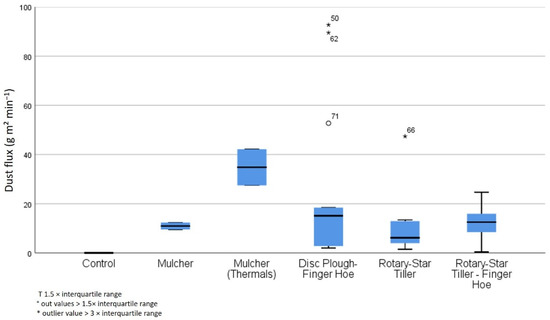
Figure 6.
Collected dust on tillage device for all tested cultivation operations and control.
The control situation (without cultivation) produced significantly lower dust flux (0.006 g m2 min−1) compared with all other tests. Mulching with impact of thermals developed during noon produced higher values (34.8 g m2 min−1) compared to the situation in the morning (10.9 g m2 min−1). From the three row tillage tools, disc plough- finger hoe (DF) had the highest mean flux (25.4 g m2 min−1), followed by rotary-star tiller- finger hoe (RF) and rotary-star tiller with 12.4 and 11.7 g m2 min−1, respectively (Table 2).

Table 2.
Mean dust flux for cultivation operations.
The mean flux on dry soil for mulching was 22.88 g m2 min−1 and for row-tillage, 16.52 g m2 min−1. No differences were found in emission flux between the test sites with mean values for test site Zeltingen (18.0 g m2 min−1) and Kues (18.3 g m2 min−1), which enabled statistical treatment as a combined set.
3.2. Parameters Influencing Dust Flux during Tillage
Apart from the factor tillage, several other parameters were tested for correlation with dust flux (Table 3). Soil water content and wind velocity correlated weakly but significantly on the 0.05 level.

Table 3.
Spearman rank coefficient for environmental parameters.
These two parameters are shown as boxplots for both tested tool combinations in Figure 7a,b. Relative categories for moisture and wind velocity were established from the available data set. Concerning both tools analyzed together, a comparison of tests according to the relative category of moisture (very dry < 5%, dry < 10%, moist < 15%, very moist ca. 20%) revealed for both the highest fluxes related to the dry categories (20.9 and 23.3 g m2 min−1 for very dry and dry, respectively) and the lowest values related to the moist categories (3.5 and 3.8 g m2 min−1 for very moist and moist, respectively) (Table 4). Concerning relative wind velocity categories (very low < 1 m s−1, low < 2 m s−1, medium ca. 3 m s−1), lower values were related to lower categories (8.1 and 10.6 g m2 min−1 for low and very low, respectively) and highest values related to the medium category (17.9 g m2 min−1) (Table 4).
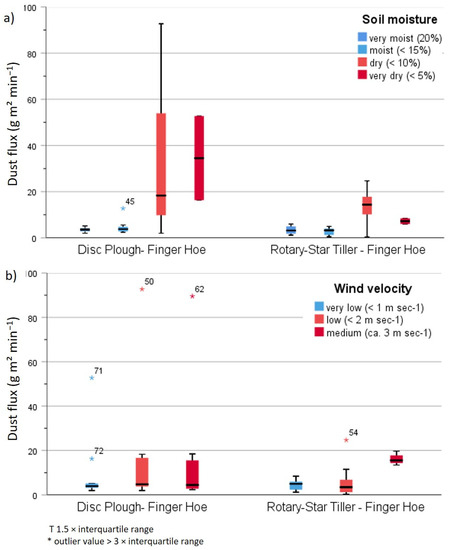
Figure 7.
Measured dust flux related to relative categories (a) soil moisture (b) wind velocity.

Table 4.
Mean dust flux for categories soil moisture and wind velocity.
3.3. Horizontal and Vertical Dust Flux
To assess the distance relation of horizontal transport, the material collected at the tillage devices (Figure 5 (1)) was compared with that collected at the masts at the end of each row (Figure 5 (2)) during tillage (same day and same heights of 0.4 and 1.0 m).
The mean values of measured material for both tool combinations together were 5.92 g m2 min−1 measured at the caterpillar and 4.18 g m2 min−1 collected at the rows’ ends (mast), showing a decrease in mean collected material with distance from spot of mobilization. The median showed no difference in collected material (Figure 8).
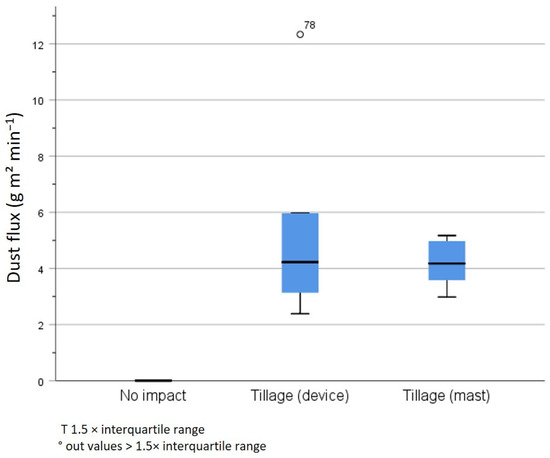
Figure 8.
Comparison of measurement spots on device and at mast for the same day and measurement height (0.4 m).
The mean collected dust at the masts in five heights decreased with height and showed an approximate power function for both tool combinations with an r2 of 0.77 for both tools (7 n). The results indicate a pattern of vertical dust transport with a decline in collected dust with height and also a comparably lower value than expected at height 0.2 m for both tools (Figure 9).
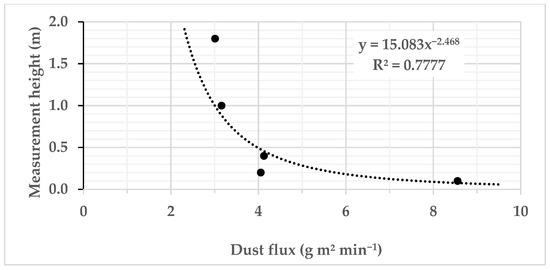
Figure 9.
Vertical distribution of collected material from masts (mean).
The distribution was not very clear and deviated considerably from the power function. If visualized as boxplots displaying median instead of mean, the collected material appeared to rise up to 0.4 m with the highest measured values at 0.4 m height (Figure 10).
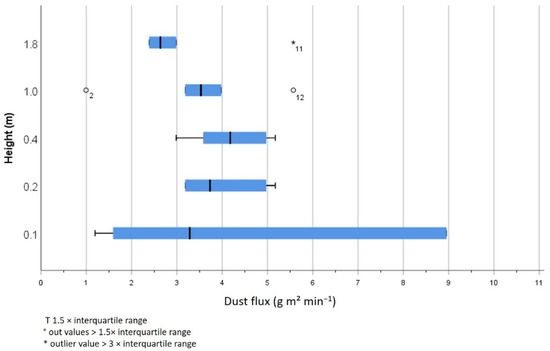
Figure 10.
Vertical distribution of collected material from masts (median).
4. Discussion
Hypotheses 1.
The tested low-cost on-site test scheme including MWAC dust samplers is adequate to quantify dust emissions from vineyards on a small temporal and spatial scale.
A relatively simple and low cost method was tested to assess dust emissions from vineyards with and without the impact of tillage over a very short duration and <100 m transport distance. The passive sampler MWAC was chosen because of global application, good sampling efficiency for larger particles [50] if only low efficiency for fine dusts [51], applicability without electricity and high derived numbers of samples, and a broad range of target particles. Active samplers are mainly applied for measurement of fine dust particles < 30 µm, whereas the target dust particles in the context of tillage on arable land are much larger. Particles < 0.84 mm are assumed to be wind erodible, but only particles with aerodynamic diameter < 100 µm may be assumed to have a sink velocity that increases the likelihood of transport beyond field boundaries as well as over longer distances. TSP from agricultural fields during wind erosion events are mainly <60 μm in aerodynamic diameter [52].
The tested steep slope vineyard sites were found to be relatively stable against processes of wind erosion without additional external impact. In the course of three test sets, the measurement on the tillage device was complemented by measurements at a greater distance and tests on very moist soil. The applied tools were changed due to considerations of the vineyard management. To assess potential horizontal transport, the material collected at the tillage device directly above the tools was compared with that collected at the same heights (0.4 m) at the end of each row during tillage. The results show that more material was collected at the tillage device directly above the tools (5.92 g m2 min−1) than at the end of the row (4.17 g m2 min−1). The explanation is related to the travel characteristics of airborne particles and the likelihood of entering the sampler. Part of the hurled material was too heavy for floating and fell back down to the ground in the closest vicinity of mobilization with the possibility of entering the collector. The airborne material then dissipated relative to particle characteristics and wind dynamics including turbulence in all directions, thus reducing the amount of particles entering the collectors at the end of the row. The decreasing concentration of TSP, which was higher at the site of mobilization (at device) and decreased with distance from the device (in all directions), reduced the probability of catching the material at the end of the row. However, the moving device changed the distance to sampler, thus reducing this effect and levelling the collected material.
All results appear plausible with respect to expected environmental conditions (moisture, wind velocity), the slight decrease in collected material with distance, as well as vertical distribution of collected material. It follows that the test setup with MWACs was restricted but suitable to measure dust flux from vineyards on a small temporal and spatial scale. Possible limitations include (1) small sample sizes because of the short-term test duration and related problems concerning reliability of measured data and (2) the choice of measurement spots as well as the movement-induced change in distance from collection spot at mast with yet unassessed impact on collected quantity. These uncertainties were partly compensated by repetitions. Although dust collectors have the advantage of allowing further use of the collected material for qualitative analysis, the amounts collected here were too low for further analysis.
To further increase the quality and validity of the test setup and the produced data, different types of dust measuring devices, such as low- and high-volume dust samplers and optical particle counters, should be used to complement the MWAC measurements.
Hypotheses 2.
Vineyards are a potential dust source particularly during cultivation activities.
The results indicate that the tested vineyards were not prone to processes of wind erosion but may be a source of considerable mineral dust triggered by mechanical operations such as tillage. The mean dust flux during control was 0.006 g m2 min−1, indicating a stable surface under low to medium wind velocities. As soon as the surface was disturbed by tillage, values rose by several orders of magnitude. For the same measurement spot (0.4 m height at the end of the row), and under environmental conditions least favorable for dust emissions (wet soil, low wind speed), the mean collected dust was 5.92 g m2 min−1 on the tillage device and 4.18 g m2 min−1 at the end of the row. That means that a mean of 4.18 g m2 min−1 was the minimal eroded soil material during a single tillage event, accounting for 98.89% of total measured dust on a per-event basis. The highest flux levels measured at the tillage device were a mean of 22.8 g m2 min−1 caused by mulching and 16.5 g m2 min−1 by tillage underneath the vines on very dry soil but even under wind velocities <5 m s−1.
The results show that mechanical external impact is the main factor for emission of TSP. Dust emissions during cultivation are much higher compared to no-tillage measurements under similar environmental parameters, supporting measurements on arable land that found soil cultivation to dramatically increase total dust [31,32]. Another mechanical impulse affecting emission of TSP was found to originate from animal trampling, where the TSP increased with the increasing number of impacts and was found to be highest on unpaved roads [53].
Mean vertical distribution measured at masts tended to decrease with height described by a power function but showed some differences from case to case (r2 = 0.77). This distribution is commonly attributed to saltation, which is the most important transport mechanism by far and decreases with height up to ca. 1 m (e.g., [54]). Since the test conditions presented here did not allow for saltation, the vertical transport pattern resulted not from processes of wind erosion but was related to mechanical impact and dissipation processes. A clue could be found by considering the peak in median collected material at 0.4 m collection height, which corresponded to the area of action related to the applied tillage tool.
These findings are relevant for the calculation of dust emission inventory and a basis for further dust dissipation studies. They also deepen the process of understanding in so far as the anthropogenic impact on wind erosion needs to be considered not only in an indirect way, e.g., by providing wind erodible surfaces, but also in a direct way by actively transferring soil particles into the air, thus neglecting the otherwise key parameter of threshold velocity. The values showed an extreme but temporally very limited rise in annual dust emission potential, which supports the results from Chen et al. [6]. The total emissions of the lower air layer are strongly influenced by regular but singular high emission events, whereby tillage is an important source that has to be carefully considered for upscaling of results.
Hypotheses 3.
The collected dust fluxes are related to environmental conditions and tillage tools.
Four different tools were tested for their impact on dust emissions, among them a mulcher and three row-tillage tool combinations.
Mulching includes the mowing and cutting of vegetation and also a disturbance of the soil surface, so that the collected dust contains a high percentage of organic matter from cutting of the dry vegetation; the highest mean dust flux was measured during its application. Among all tests, tests at noon (mulcher/thermals) showed significantly more erosion due to the support of dust transport by comparably strong uphill thermal winds compared to the two tests conducted in the morning hours (mulcher). This indicates that wind may have a strong influence on the total emitted dust not in terms of detachment but in terms of dissipation and transport of the already airborne particles.
Different dust fluxes were measured during the application of three under-row tillage tools: a rotary-star tiller–finger hoe (RT-FH), a disc plough–finger hoe (DP-FH) and rotary-star tillers (RT). The highest mean TSP was collected during use of the disc-plough combination, which may be explained by the mechanical operation involving a rotating disc working the soil surface underneath the vines during which material is hurled into the air. Among the operations tested by Öttl and Funk [55], the disc plough was associated with the second highest amount of airborne dust particles measured by means of an optical particle counter. They could verify a strong impact from tillage as well as a strong interdependence with soil moisture, which was also confirmed by Funk et al. [32].
Compared to tillage, soil moisture and wind velocity have a minor impact, but they were found to be clearly related to the measured emission flux. The highest emission flux was measured under conditions of low soil moisture and higher wind velocities. This indicates that even in the case of impact-induced dust, where wind shear and soil water are not the key factors determining detachment, they are still determining parameters for the dissipation of airborne particles.
The specific externally triggered type of mineral dust production during tillage operations may be of highest importance for the case of humid or sub-humid agricultural land, since these effects may account for a great proportion of total emissions from a site during a year. As short-term suspended materials, they may influence surrounding habitats through the transport of nutrients, pollutants and microorganisms as well as negatively affect human health. The side effects include also contamination of settlements and damage to infrastructure such as solar panels. A part of the measured mineral fine dusts may connect to the global dust transport. Their parameters are then important input variables for modeling the radiation properties of dust layers, cloud formation and air chemistry. Mechanical impact may be a source of dust emissions accounting for a significant proportion of the total regional dust inventory, particularly in connection with several effects of climate change altering key parameters for the agricultural sector.
5. Conclusions
Dust emissions from vineyards are not only important due to the sorting action of wind erosion, which causes the on-site loss of the fine grain sizes including silts and clays. In addition to their importance for structure formation and water balance, they bind nutrients, but also pollutants such as pesticides and heavy metals, which may be relocated on a local to regional scale.
- The first quantifications of agricultural dust from vineyards with and without tillage impact show a considerable impact of tillage on total dust, which may account for singular but regular high emission events.
- Mechanical tillage operations are progressively applied to replace chemical treatments such as pesticides and herbicides. The disturbance of topsoil may enhance tillage-induced dust emissions and need to be considered for a comprehensive impact assessment.
- Climate change induced dry spells increase the number of days inadequate for tillage due to soil and climate conditions that enhance wind erosion and dust emissions. Thus, the total potential for dust emissions from vineyards may rise in the medium term.
- These high-emission events are not reflected by wind erosion models since they are not determined by soil or climate-related parameters. Including the mechanical impact into dust emission modeling is vital for a reliable risk assessment.
- The test setup was adequate for measurement of agricultural tillage operations and should be complemented by low- and high-volume sampling methods and optical particle samplers.
- Knowledge about the effects of specific management operations has great potential to provide a valuable tool for climate change mitigation and adaption strategies to support sustainable soil management.
Author Contributions
Conceptualization, M.M. and J.B.R.; methodology, M.M.; formal analysis, M.M.; investigation, M.M.; resources, M.P. and J.B.R.; data curation, M.M.; writing—original draft preparation, M.M.; writing—review and editing, M.M., M.P., J.B.R.; visualization, M.M.; supervision, M.M. and J.B.R. All authors have read and agreed to the published version of the manuscript.
Funding
The publication costs were funded by the Trier University publishing fund.
Institutional Review Board Statement
Not applicable.
Informed Consent Statement
Not applicable.
Data Availability Statement
The data are available from the corresponding author.
Acknowledgments
The authors would like to thank the DLR staff for supporting the study.
Conflicts of Interest
The authors declare no conflict of interest.
References
- Shepherd, G.; Terradellas, E.; Baklanov, A.; Kang, U.; Sprigg, W.; Nickovic, S.; Boloorani, A.D.; Al-Dousari, A.; Basart, S.; Benedetti, A. Global Assessment of Sand and Dust Storms; UNEP, WMO, UNCCD; United Nations Environment Programme: Nairobi, Kenya, 2016. [Google Scholar]
- Goudie, A.S.; Middleton, N.J. Desert Dust in the Global System; Springer Science & Business Media: Berlin/Heidelberg, Germany, 2006; ISBN 978-3-540-32355-6. [Google Scholar]
- Katra, I. Soil erosion by wind and dust emission in semi-arid soils due to agricultural activities. Agronomy 2020, 10, 89. [Google Scholar] [CrossRef] [Green Version]
- Mc Tainsh, G.H.; Leys, J.F. Wind erosion. In Land Degradation Processes in Australia; Mc Tainsh, G.H., Boughton, W.C., Eds.; Longman-Cheshire Pty Limited: Melbourne, Australia, 1993; pp. 188–233. [Google Scholar]
- Webb, N.P.; Herrick, J.E.; Van Zee, J.W.; Courtright, E.M.; Hugenholtz, C.H.; Zobeck, T.M.; Okin, G.S.; Barchyn, T.E.; Billings, B.J.; Boyd, R.; et al. The national wind erosion research network: Building a standardized long-term data resource for aeolian research, modeling and land management. Aeolian Res. 2016, 22, 23–36. [Google Scholar] [CrossRef] [Green Version]
- Chen, W.; Tong, D.; Zhang, S.; Dan, M.; Zhang, X.; Zhao, H. Temporal variability of atmospheric particulate matter and chemical composition during a growing season at an agricultural site in Northeastern China. J. Environ. Sci. 2015, 38, 133–141. [Google Scholar] [CrossRef]
- Bärring, L.; Jönsson, P.; Mattsson, J.O.; Åhman, R. Wind erosion on arable land in scania, sweden and the relation to the wind climate—A review. Catena 2003, 52, 173–190. [Google Scholar] [CrossRef]
- Gomes, L.; Arrúe, J.L.; López, M.V.; Sterk, G.; Richard, D.; Gracia, R.; Sabre, M.; Gaudichet, A.; Frangi, J.P. Wind erosion in a semiarid agricultural area of Spain: The WELSONS project. Catena 2003, 52, 235–256. [Google Scholar] [CrossRef] [Green Version]
- Warren, A. Wind Erosion on Agricultural Land in Europe: Research Results for Land Managers; European Commission: Brussels, Belgium, 2002; ISBN 92-894-3958-0. [Google Scholar]
- IPCC. IPCC Special Report on Climate Change, Desertification, LandDegradation, Sustainable Land Management, Food Security, and Greenhouse Gas Fluxes in Terrestrial Ecosystems; 2019. Available online: https://www.ipcc.ch/srccl/ (accessed on 5 October 2021).
- Lal, R. Desertification and soil erosion. Glob. Environ. Chang. 2014, 1, 369–378. [Google Scholar]
- Steininger, M.; Wurbs, D. Bundesweite Gefährdung Der Böden Durch Winderosion Und Bewertung Der Veränderung Infolge Des Wandels Klimatischer Steuergrößen Als Grundlage Zur Weiterentwicklung Der Vorsorge Und Gefahrenabwehr Im Bodenschutzrecht. Umweltbundesamt-Texte 2017, 13, 119. [Google Scholar]
- Ginoux, P.; Prospero, J.M.; Gill, T.E.; Hsu, N.C.; Zhao, M. Global-scale attribution of anthropogenic and natural dust sources and their emission rates based on MODIS deep blue aerosol products. Rev. Geophys. 2012, 50. [Google Scholar] [CrossRef]
- Miller, R.L.; Tegen, I.; Perlwitz, J. Surface radiative forcing by soil dust aerosols and the hydrologic cycle. J. Geophys. Res. Atmos. 2004, 109. [Google Scholar] [CrossRef]
- Kok, J.F. A scaling theory for the size distribution of emitted dust aerosols suggests climate models underestimate the size of the global dust cycle. Proc. Natl. Acad. Sci. USA 2011, 108, 1016–1021. [Google Scholar] [CrossRef] [Green Version]
- Middleton, N.J. Desert dust hazards: A global review. Aeolian Res. 2017, 24, 53–63. [Google Scholar] [CrossRef]
- Buschiazzo, D.; Funk, R. Wind erosion of agricultural soils and the carbon cycle. In Soil Carbon: Science, Management and Policy for Multiple Benefits; Banwart, S.A., Noellemeyer, E., Milne, E., Eds.; CABI: Oxfordshire, UK, 2014. [Google Scholar] [CrossRef]
- Chepil, W.S. Conversion of relative field erodibility to annual soil loss by wind. Soil Sci. Soc. Am. J. 1960, 24, 143–145. [Google Scholar] [CrossRef]
- Field, J.P.; Belnap, J.; Breshears, D.D.; Neff, J.C.; Okin, G.S.; Whicker, J.J.; Painter, T.H.; Ravi, S.; Reheis, M.C.; Reynolds, R.L. The ecology of dust. Front. Ecol. Environ. 2010, 8, 423–430. [Google Scholar] [CrossRef] [Green Version]
- Katra, I.; Gross, A.; Swet, N.; Tanner, S.; Krasnov, H.; Angert, A. Substantial dust loss of bioavailable phosphorus from agricultural soils. Sci. Rep. 2016, 6, 24736. [Google Scholar] [CrossRef] [PubMed] [Green Version]
- Schenker, M.B.; Pinkerton, K.E.; Mitchell, D.; Vallyathan, V.; Elvine-Kreis, B.; Green, F.H.Y. Pneumoconiosis from agricultural dust exposure among young california farmworkers. Environ. Health Perspect. 2009, 117, 988–994. [Google Scholar] [CrossRef] [Green Version]
- Kok, J.F.; Ridley, D.A.; Zhou, Q.; Miller, R.L.; Zhao, C.; Heald, C.L.; Ward, D.S.; Albani, S.; Haustein, K. Smaller desert dust cooling effect estimated from analysis of dust size and abundance. Nat. Geosci. 2017, 10, 274–278. [Google Scholar] [CrossRef]
- Tozer, P.; Leys, J.; Tozer, P.; Leys, J. Dust storms—What do they really cost? Rangel. J. 2013, 35, 131–142. [Google Scholar] [CrossRef] [Green Version]
- Riksen, M.J.P.M.; de Graaff, J. On-site and off-site effects of wind erosion on european light soils. Land Degrad. Dev. 2001, 12, 1–11. [Google Scholar] [CrossRef]
- Mahowald, N.M.; Scanza, R.; Brahney, J.; Goodale, C.L.; Hess, P.G.; Moore, J.K.; Neff, J. Aerosol deposition impacts on land and ocean carbon cycles. Curr. Clim. Chang. Rep. 2017, 3, 16–31. [Google Scholar] [CrossRef] [Green Version]
- Li, J.; Kandakji, T.; Lee, J.A.; Tatarko, J.; Blackwell, J.; Gill, T.E.; Collins, J.D. Blowing dust and highway safety in the Southwestern United States: Characteristics of dust emission “hotspots” and management implications. Sci. Total Environ. 2018, 621, 1023–1032. [Google Scholar] [CrossRef]
- World Health Organization. WHO Global Air Quality Guidelines: Particulate Matter (PM2.5 and PM10), Ozone, Nitrogen Dioxide, Sulfur Dioxide and Carbon Monoxide; Executive Summary: Geneva, Switzerland, 2021. [Google Scholar]
- Air Quality Directive 2008. Available online: https://eur-lex.europa.eu/eli/dir/2008/50/2015-09-18 (accessed on 22 November 2021).
- Singh, P.; Sharratt, B.; Schillinger, W.F. Wind erosion and PM10 emission affected by tillage systems in the world’s driest rainfed wheat region. Soil Tillage Res. 2012, 124, 219–225. [Google Scholar] [CrossRef]
- Duniway, M.C.; Geiger, E.L.; Minnick, T.J.; Phillips, S.L.; Belnap, J. Insights from long-term ungrazed and grazed watersheds in a salt desert colorado plateau ecosystem. Rangel. Ecol. Manag. 2018, 71, 492–505. [Google Scholar] [CrossRef]
- Goossens, D.; Gross, J.; Spaan, W. Aeolian dust dynamics in agricultural land areas in Lower Saxony, Germany. Earth Surf. Process. Landf. 2001, 26, 701–720. [Google Scholar] [CrossRef]
- Funk, R.; Reuter, H.I.; Hoffmann, C.; Engel, W.; Öttl, D. Effect of moisture on fine dust emission from tillage operations on agricultural soils. Earth Surf. Process. Landf. 2008, 33, 1851–1863. [Google Scholar] [CrossRef]
- Riksen, M.J.P.M. Off-site effects of wind erosion on agricultural land in Northwestern Europe. In Wind Erosion and Dust Dynamics: Observations, Simulations, Modelling; Goossens, D., Riksen, M.J.P.M., Eds.; ESW Publications: Wageningen, The Netherlands, 2004; pp. 103–121. [Google Scholar]
- Chappell, A.; Webb, N.P.; Butler, H.J.; Strong, C.L.; McTainsh, G.H.; Leys, J.F.; Viscarra Rossel, R.A. Soil organic carbon dust emission: An omitted global source of atmospheric CO2. Glob. Chang. Biol. 2013, 19, 3238–3244. [Google Scholar] [CrossRef]
- Bagnold, R.A. The Physics of Blown Sand and Desert Dunes; William Morrow: New York, NY, USA, 1941. [Google Scholar]
- Owen, P.R. Saltation of uniform grains in air. J. Fluid Mech. 1964, 20, 225–242. [Google Scholar] [CrossRef]
- Gillette, D.A.; Herbert, G.; Stockton, P.H.; Owen, P.R. Causes of the fetch effect in wind erosion. Earth Surf. Process. Landf. 1996, 21, 641–659. [Google Scholar] [CrossRef]
- Shao, Y.; Raupach, M.R.; Findlater, P.A. Effect of saltation bombardment on the entrainment of dust by wind. J. Geophys. Res. Atmos. 1993, 98, 12719–12726. [Google Scholar] [CrossRef] [Green Version]
- Grini, A.; Zender, C.S. Roles of saltation, sandblasting, and wind speed variability on mineral dust aerosol size distribution during the Puerto Rican Dust Experiment (PRIDE). J. Geophys. Res. Atmos. 2004, 109. [Google Scholar] [CrossRef] [Green Version]
- Shao, Y. Physics and Modelling of Wind Erosion; Springer: Berlin/Heidelberg, Germany, 2008; Volume 37. [Google Scholar]
- Alfaro, S.C.; Gomes, L. Modeling mineral aerosol production by wind erosion: Emission intensities and aerosol size distributions in source areas. J. Geophys. Res. Atmos. 2001, 106, 18075–18084. [Google Scholar] [CrossRef]
- Bullard, J. Bridging the gap between field data and global models: Current strategies in aeolian research. Earth Surf. Process. Landf. 2010, 35, 496–499. [Google Scholar] [CrossRef] [Green Version]
- Klose, M.; Gill, T.E.; Etyemezian, V.; Nikolich, G.; Ghodsi Zadeh, Z.; Webb, N.P.; Van Pelt, R.S. Dust emission from crusted surfaces: Insights from field measurements and modelling. Aeolian Res. 2019, 40, 1–14. [Google Scholar] [CrossRef]
- Cook, E. (Ed.) Agriculture, Forestry and Fishery Statistics, 2019; Publications Office of the European Union: Luxembourg, 2019; ISBN 978-92-76-13193-9. [Google Scholar]
- Rodrigo Comino, J.; Iserloh, T.; Lassu, T.; Cerdà, A.; Keestra, S.D.; Prosdocimi, M.; Brings, C.; Marzen, M.; Ramos, M.C.; Senciales, J.M.; et al. Quantitative comparison of initial soil erosion processes and runoff generation in spanish and german vineyards. Sci. Total Environ. 2016, 565, 1165–1174. [Google Scholar] [CrossRef]
- Cerdan, O.; Govers, G.; Le Bissonnais, Y.; Van Oost, K.; Poesen, J.; Saby, N.; Gobin, A.; Vacca, A.; Quinton, J.; Auerswald, K.; et al. Rates and spatial variations of soil erosion in Europe: A study based on erosion plot data. Geomorphology 2010, 122, 167–177. [Google Scholar] [CrossRef]
- Novara, A.; Stallone, G.; Cerdà, A.; Gristina, L. The effect of shallow tillage on soil erosion in a semi-arid vineyard. Agronomy 2019, 9, 257. [Google Scholar] [CrossRef] [Green Version]
- IBM Corp. IBM SPSS Statistics for Windows; Version 27.0; IBM Corp: Armonk, NY, USA, 2020. [Google Scholar]
- Microsoft Corporation. Microsoft Excel. 2018. Available online: Https://Office.Microsoft.Com/Excel (accessed on 5 October 2021).
- Goossens, D.; Offer, Z.Y. Wind tunnel and field calibration of six aeolian dust samplers. Atmos. Environ. 2000, 34, 1043–1057. [Google Scholar] [CrossRef]
- Mendez, M.J.; Funk, R.; Buschiazzo, D.E. Efficiency of Big Spring Number Eight (BSNE) and Modified Wilson and Cook (MWAC) samplers to collect PM10, PM2.5 and PM1. Aeolian Res. 2016, 21, 37–44. [Google Scholar] [CrossRef]
- Goossens, D. On-site and off-site effects of wind erosion. In Wind Erosion on Agricultural Land in Europe: Research Results for Land Managers; Warren, A., Ed.; European Commission, Directorate-General for Research: Luxembourg, 2002; pp. 29–38. [Google Scholar]
- De Oro, L.A.; Avecilla, F.; Panebianco, J.E.; Buschiazzo, D.E. PM10 emission from feedlots in soils with different texture: Cattle trampling effect. Aeolian Res. 2021, 53, 100742. [Google Scholar] [CrossRef]
- Sterk, G.; Raats, P.A.C. Comparison of models describing the vertical distribution of wind-eroded sediment. Soil Sci. Soc. Am. J. 1996, 60, 1914–1919. [Google Scholar] [CrossRef]
- Öttl, D.; Funk, R. PM Emission factors for farming activities by means of dispersion modeling. Part. Matter Agric. 2007, 308, 173–177. [Google Scholar]
Publisher’s Note: MDPI stays neutral with regard to jurisdictional claims in published maps and institutional affiliations. |
© 2022 by the authors. Licensee MDPI, Basel, Switzerland. This article is an open access article distributed under the terms and conditions of the Creative Commons Attribution (CC BY) license (https://creativecommons.org/licenses/by/4.0/).